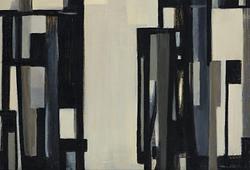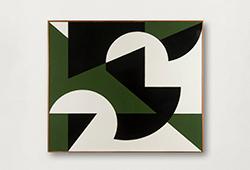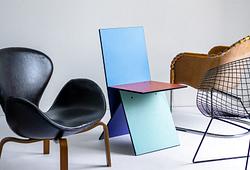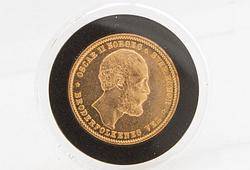Åke Göransson
"Landskap med svart himmel"
Signed with stamp Åke G. Executed in 1933/37. Canvas relined on panel 30 x 26.5 cm.
Provenance
Doctor Gunnar Jönsson, Bromma,
Private collection, Sweden.
Exhibitions
Konsthallen Göteborg, cat. no. 156.
Stenmans dotter, Stockholm, 1944.
Stenmans, Stockholm, 1957, cat. no. 44.
Göteborgs konstmuseum, 11 May- 21 August, 1977, cat no. 67.
Liljevalchs Konsthall, Stockholm, 1977-78, cat.no. 73.
Literature
Arne Stubelius, "Åke Göransson", 1952, mentioned p. 90.
Björn Axlund, "Färgformen - Åke Göranssons liv och konst", 2002, upptagen i Catalogue Raisonné, cat. no. 207, p. 199.
More information
1924 blev Åke Göransson deltidselev på Valands målarskola, hans närvaro var tidvis mycket sporadisk, eftersom hans knappa ekonomiska situation tvingade honom att arbeta halvtid som frisörbiträde och han var även något av en enstöring. Men på skolan sällade han sig till de unga konstnärer som slöt upp runt läraren Tor Bjurström. Efter en kort period av glädje och tillhörighet med andra konstnärer började tendenserna till mental ohälsa att visa sig. Från 1932 tog sig Göransson knappt ut och belägrade sig i sin mors etta i Landala och det är också där som de allra märkligaste och intensivaste konstverken tillkommer. 1937 togs han in på Lillhagen, Göteborgs nya mentalsjukhus. Han var i uselt skick, både psykiskt och fysiskt med en vikt på endast 48 kilo och tuberkulos i lungorna och fullt utvecklad schizofreni. Åke Göransson blev kvar på Lillhagen de återstående fem åren av sitt liv innan tuberkulosen tog hans liv.
Om Göteborgskoloristerna förknippas med färgexplosioner utgör Göransson undantaget i den sammanslutningen av konstnärer. Hans tidiga, små landskapsmålningar i dämpade färgskalor anses främst inspirerade av Cézanne och i viss mån Aguéli. Snart fann han dock en mycket personlig stil, om det aktuella katalognumret skriver Stubelius: "Vem vill t.ex. kalla något av de tre mycket sena landskapen utanför gatornas rad sjuka. 'Landskap med svart himmel' gör skäl för namnet. Över den gröna terrängen med dess gula och röda huskomplex, som verkar belyst av en flammande eld, välver sig en rent sotsvart himmel, och vattnet som speglar byggnaderna är blåsvart. En tungt ödesmättad atmosfär vilar över tavlan, till vilken konstnären möjligen kan ha hämtat motiv från Vallgraven i Göteborg, och det gula huset skulle i så fall vara Stora teatern - hur visionära Göranssons målningar än kan verka har de ju nästan alltid sitt enkla verklighetsunderlag".
A tergo intygad 2/11 1941 av Hanna Göransson och Arne Stubelius.
Artist
Åke Göransson was born in Veddige in Halland 1902. His parents were shoemaker Sven GÖransson and his wife Hanna. Sven Göransson died when Åke was only three years od and thus his mother Hanna came to play a big role in Åke's life, both as a breadwinner and a support system. Åke eventually starts working as a barbor, drawing and painting on the side for Hermods. He eventually got engaged to Inga Andersson. In 1924, Åke becomes a part time student at Valand's art school, but his tricky economic situation forces him to work halftime as a barbor. He became somewhat of a hermit, but at school he spent time with other artists who railed around their teacher Tor Bjurström. After a short period of stability begins the tendancies of poor mental health show itself. From 1932 his health deteriorates, he is deemed mentally insane, and he finds himself to leave his mothers apartment in Landala. It is from this period that the most interesting and intensive paintings were made. Torn from the world, Göransson continuously paints new versions of his view of Egnahemsvägenin Landala, interiors from the studio flat, with Hannah often lurking in the photographs. His friends from his studies find themselves intranced by his canvas paintings, and his friend Ivan Ivarson convinces Göransson to lend three artworks to the collection exhibition of 1933 at Paletten in Gothenburg. The exhibition is greatly received and brings national fame to Göransson's art. However, he is simultaneously experiencing an internal crisis and depression, and it becomes impossible for im to continue painting, and thus cannot continue to support his wife and daughter Ingrid. After this his artworks fluctuates with his state of mind, the dark is contrasted with the light, light with darkness. In the long run, his mother can no longer continue to support him with all of the art supplies he needs, and he instead begins to paint over old canvases. In 1937 Göransson was finally emitted into Gothenburgs new mental hospital. He was in terrible form, both mentally and physically, since he suffered from tuberkulosis, weighed only 48 kilos, and had full fledged schizophrenia. He remained at the hospital until his death in 1942.
Åke Göransson's artistic career would likely have faded into obscurity if Arne Stubelius had not made a spontaneous visit to Göransson's mother, Hanna, one summer day in 1940.Stublius worked with monographs like Ivan Ivarson and wanted to verify some facts. One time, Stublius asked if there were any more of Göransson's art left in the home. Göransson's mother asked her son to mobe off the sofa, where upon opening the sofa cover, they found the home of Göransson's art. This marked the beginning of Åke Göransson’s artistic career being brought into the spotlight. Through purchases, Gösta Stenman enabled the rescue of the works. They were restored, mounted on panels, and framed. The exhibition at Modern Konst i Hemmiljö on Strandvägen in Stockholm in 1941 was received very positively and marked the start of significant attention towards Göransson’s work. Only a few paintings were created in the hospital the following year before Åke Göransson passed away from mental exhaustion and tuberculosis in 1942.
Read more

































